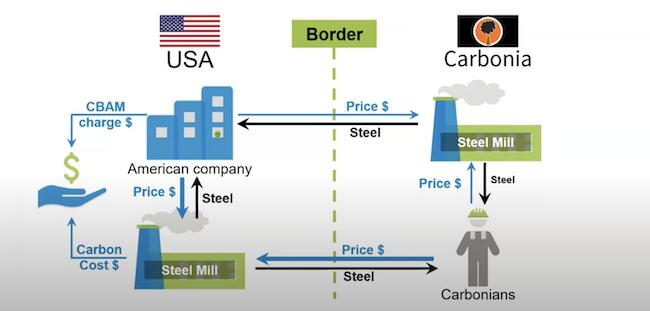One of CCL’s recent calls to action has been to tell Congress to pass the PROVE IT Act. That’s a bipartisan bill introduced in the Senate that would take the first step toward establishing a U.S. carbon border adjustment mechanism, or CBAM.
We recently held a Citizens’ Climate University training to educate CCL volunteers about CBAMs and the PROVE IT Act. CCL Research Coordinators Dana Nuccitelli and Rick Knight discussed the purpose of CBAMs, how they work, the role the PROVE IT Act would play in developing a U.S. CBAM, and the status of CBAMs around the world. Watch the full training here or read on for a recap:
What does a CBAM do?
As Dana explained, most American industries produce materials and products that tend to have a lower carbon intensity than many foreign competitors. There are a few reasons for that, even though the U.S. hasn’t yet implemented a carbon price. For example, we have strong regulations, efficient and advanced manufacturing, and relatively clean power generation. While these factors tend to result in lower-carbon domestic products, they also add costs for American companies, which often gives dirtier foreign competition a financial advantage.
A CBAM would level that playing field by calculating the carbon intensity of certain domestic and foreign products and then imposing a carbon fee on the extra carbon footprint of products imported into the U.S. The CBAM could also refund domestic products for their lower carbon footprint when they’re exported across our border, so that they can better compete in other countries’ markets.
This would create a greater financial incentive to buy low-carbon products made in America, thus reducing U.S. carbon pollution, and also encourage industries in other countries to reduce the carbon intensity of their products in order to avoid paying the CBAM. Rick described this process in easy to understand terms by using a hypothetical example of trade between the U.S. and the fictional high-carbon country of Carbonia.
How do we create a CBAM?
As Rick discussed, establishing a CBAM in the U.S. would be a three-step process. The first step involves calculating the carbon intensity of a variety of American industries and foreign competitors. That’s exactly what the PROVE IT Act would task the Department of Energy with doing.
Once we know the difference in carbon intensities between domestic and foreign products, the second step involves deciding the carbon price to apply to the excess carbon content of products being imported across our border. This would be simpler to do if the U.S. had a domestic carbon price in place, which CCL will continue to advocate for. But Dana outlined a few different ways to select the CBAM carbon price, which were included in CBAM bills in the last session of Congress from Sen. Sheldon Whitehouse (D-RI) and Sen. Chris Coons (D-DE).
Finally, once we know the excess carbon intensity of various products from different countries and the desired carbon price, the third step is to pass a CBAM bill that implements this information. Several members of Congress are reportedly working on CBAM legislation right now, so we hope to be able to dive into the details of some new CBAM bills later this year.
Other countries are establishing CBAMs
In the meantime, several other countries are moving forward with their own CBAMs. The European Union is in the process of establishing the carbon intensities of several industries, much like the PROVE IT Act would do, and will use those values to enforce their own CBAM starting in 2026. Japan plans to apply a CBAM just to fossil fuels in 2028, and the United Kingdom and Canada are considering CBAMs that may look similar to the EU’s. Seeing so many allies and major trading partners moving forward creates extra incentive for U.S. policymakers to implement our own CBAM here, and the PROVE IT Act would be a key first step in that process.
Want to help? Make sure your members of Congress have heard from you on this issue. Send them a message with this easy, online action tool that identifies your senators for you and makes it simple to contact them supporting the PROVE IT Act. Let’s make it happen!






